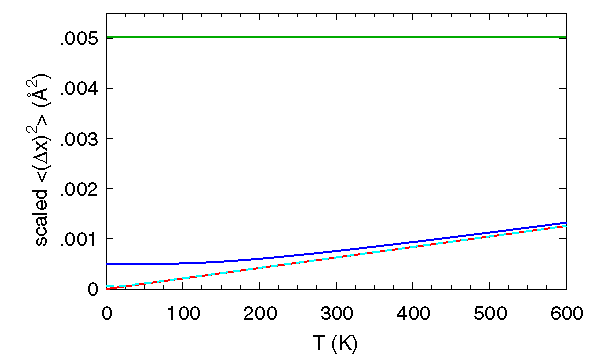


Next: Overall Comparison - What
Up: Classical vs. Quantum Mechanics:
Previous: Average Energy U and
Mean-Square Fluctuation
One physical quantity of great interest is the variance in the position of atoms at equilibrium,
 .
For our model oscillator,
.
For our model oscillator,
 ; so
; so
 .
This mean-square fluctuation about the average position is related to the B factors
of crystallography and is also measurable by neutron scattering [3] and by Mössbauer spectroscopy [4].
It is one of the most important quantities to keep an eye on in molecular dynamics simulations as well.
What is this fluctuation for the harmonic oscillator in equilibrium at constant
.
This mean-square fluctuation about the average position is related to the B factors
of crystallography and is also measurable by neutron scattering [3] and by Mössbauer spectroscopy [4].
It is one of the most important quantities to keep an eye on in molecular dynamics simulations as well.
What is this fluctuation for the harmonic oscillator in equilibrium at constant
 according to classical and quantum mechanics? We again use equations 2, 4, and 5,
now with
according to classical and quantum mechanics? We again use equations 2, 4, and 5,
now with  , and consider the
same three frequencies of proton vibration.
Because
, and consider the
same three frequencies of proton vibration.
Because  and
and
 for harmonic oscillation,
the quantum and classical results are proportional to those obtained above for the average energy.
That is,
for harmonic oscillation,
the quantum and classical results are proportional to those obtained above for the average energy.
That is,
 . Again, m is taken as the mass of a proton.
(To plot the three frequencies on one scale, results
have been scaled to the f = 100/ps values (green): Results for f = 10/ps (blue) were scaled by 0.01 ; results for f = 1/ps (cyan)
were scaled by 0.0001. Consequently, the three classical curves (red),
. Again, m is taken as the mass of a proton.
(To plot the three frequencies on one scale, results
have been scaled to the f = 100/ps values (green): Results for f = 10/ps (blue) were scaled by 0.01 ; results for f = 1/ps (cyan)
were scaled by 0.0001. Consequently, the three classical curves (red),
 , coincide.)
, coincide.)
 |
| Mean-square fluctuation of H atom undergoing harmonic oscillation. |



Next: Overall Comparison - What
Up: Classical vs. Quantum Mechanics:
Previous: Average Energy U and
Steinbach
2019-02-01

